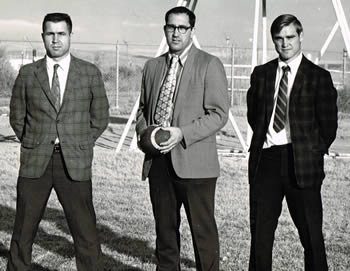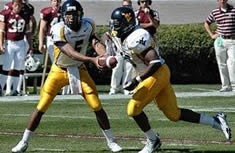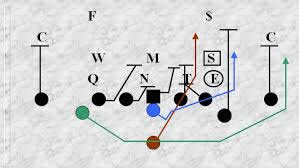
In Part I of this reflection, Practicing the Faith (Part I), I reminisced about my days coaching high school football in Glenrock, Wyoming, and how the experiences there taught me something about faith and the need for discipline ... and practice.
Much of practice is repetition so that desired actions and behaviors become automatic, so they do not require the micro seconds of time to think. A coaching mantra is, "React, don't think!" If you have to take time to think, your reaction will be too late. And, desired reaction takes repetition. Do it again! ... And again!
In particular, I remember working with our quarterback, Mike, on "reading" the keys for the triple option. In this mainstay of modern football, on the snap, the quarterback sticks the ball to the gut of the fullback diving off-tackle. If the defensive tackle goes for the fullback, the QB pulls the ball and continues down the line toward the defensive end, the offensive halfback trailing. If the defensive end hesitates to cover the trailing halfback, the QB keeps the ball and cuts up field. If the end goes for the quarterback, the QB pitches to the trailing halfback. Read and react! (See Navy's offense on a long drive emphasizing the triple option in the Resources below.) Practice it again and again! Read the keys. Again ... and again!

Often, while a trainer worked with the rest of the team on warm-downs, my assistants Ev and Bob, and I would work as a skeleton defense with the our quarterback, fullback, and halfback repeating the reads of the triple option. Coaches on defense would vary their reaction, and the backfield would adjust their reads accordingly. "Ride, pull, read the end, pitch!" Do it again, this time: "ride, give to the fullback, fake a pitch!" Do it again! And again! Fifteen to 20 repetitions. Don't think! React!
After such a practice session, I'd tell Mike, "When you go to bed, don't think about the cheerleaders, practice the option!" "I know, coach," the QB would respond: "Psycho-Cybernetics." I'd follow, "And when day-dreaming in class -- not in my chemistry class of course ..." "Yeah coach, Psycho-Cybernetics!"
Psycho-Cybernetics: A technique of practicing in one's mind. If you've ever seen a golfer on TV standing by her ball in the fairway, staring intently toward the hole (as if in meditation), very likely she is doing psycho-cybernetics. The golfer is imagining the club in hand coming toward the ball, sensing the hit, and following through. Then "seeing" the ball fly toward the green. Also likely, the golfer has done this hundreds of times while alone relaxing.
Much of the science of Psycho-Cybernetics was done by Dr. Maxwell Maltz and compiled into a book by the same namePsycho-Cybernetics, Maxwell Maltz, Prentice-Hall, inc., 1960. in 1960. Briefly, Psycho-Cybernetics involves repetition in the mind of an exercise, imagining it as real, and providing feedback from errors that might be made in these simulations. The classic experiment of Psycho-Cybernetics illustrates the power of this "practicing in one's mind:"
Three groups of students were given a pre-test of basketball free-throwing ability. Then for 20 days, Group A came to the gym and practiced free throws for 20 minutes as would be usual. Group B came to the gym for their 20 minutes, but just sat on a bench looking at the net and imagined themselves shooting, "feeling" the ball in their hands, and trying to self-correct if they missed. Group C, acting as a control group did nothing.
At the end of the 20 days, all groups were re-tested. As expected, Group C's results showed no improvement. Group A (ones actually practicing) improved 24%. The ones employing Psycho-Cybernetics (Group B) improved 23% ... nearly the same as the ones who physically practiced!
One of the keys to success in this mind-practicing is to put oneself into the picture. It's not like one is watching a film of
someone practicing the routine. In psycho-cybernetics, people imagine themselves in action, sensing the surroundings, feeling the smells and sounds
Your nervous system cannot tell the difference between an imagined experience and a 'real' experience.
Maxwell Maltz,
Author of Psycho-Cybernetics
involved in the real thing. Then, when a mistake is made, say the ball bounces off the rim, adjust and do it again.
When I taught my quarterback these techniques for "practicing" the triple option in his head, I had him imagine the sting of the center snapping the ball into his hands, smell the fresh-cut grass in the fall evening, hear the crowd noise, feel holding the ball against the fullback's stomach. See the defensive tackle, then the defensive end. Over and over!
When writing Part I of this Reflection, I realized that the "practice" I was talking about was the discipline of doing things like reading scripture, meditation, prayer, and such. Not practice like in football practice. Practice to get better. Can one "practice" loving one's neighbor? Practice giving a soft answer to turn away wrath? Then, I thought: sure you can! Maybe practice these things with friends. But, maybe make practice part of prayer and meditation ... using Psycho-Cybernetics.
Perhaps God has stimulated you to want to improve interaction with another person. Consider this scenario: You're part of a small group that meets at breakfast for scripture reading, discussion, and prayer. One woman's responses often grate you because her view of how to interpret scripture is quite different than yours. But, rather than challenge, you usually stay silent not wanting to sound threatening. However, you go away feeling you simply went along and never suggested an alternative view to the group ... and were not true to your own beliefs. Through prayer, you have realized there are responses in love you can give that would be helpful, not threatening or alienating.
When alone, perhaps in meditation, give Psycho-Cybernetics a try. (Maybe you can ask God or Jesus to be your coach. In fact, a key role of the Holy Spirit seems to be that of a coach!) Close your eyes and imagine yourself with your group around the breakfast table. Smell the bacon frying, feel the warmth of the coffee cup, hear the background chatter of other patrons. Make it real: you aren't watching; you are there! Feel your face flush when she states what you think a simplistic opinion. Breathe deeply, smile and give your rehearsed response. See the supporting nod of a colleague. Consider what you might have phrased better. Ask Jesus for his feedback. Does Coach God have any suggestions? Go through the whole exercise again. And again.
Next time at breakfast, you might find you've increased the chances you give the type of loving, honest response you really want to give.
We know God wants us to grow. We probably know where we need to grow. We know, too, that growth isn't always easy ... or natural. Maybe practice can help. And surely God is willing to carry a whistle and be our coach. I kind of think God would enjoy calling the plays and barking the signals:
"OK. 'Smile at Strangers' ... on the third Hut. Break! ... HUT! ... HUT HUT!"
Give it a try ... Practice, practice, practice!
Coach Dodd







